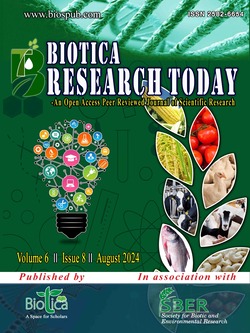
Role of Artificial Intelligence in Natural Resource Management
M.L. Dotaniya*
ICAR-Directorate of Rapeseed-Mustard Research, Bharatpur, Rajasthan (321 303), India
Kuldeep Kumar
ICAR-Indian Institute of Soil and Water Conservation, RS Kota, Rajasthan (324 002), India
C.K. Dotaniya
Swami Keshwanand Rajasthan Agriculture University, Bikaner, Rajasthan (334 006), India
H.M. Meena
ICAR-Central Arid Zone Research Institute, Jodhpur, Rajasthan (342 003), India
R.K. Doutaniya
Dept. of Agronomy, SKN College of Agriculture, Jobner, Rajasthan (303 328), India
Anita Meena
ICAR-Central Institute for Arid Horticulture, Bikaner, Rajasthan (334 006), India
Harpreet Singh
Regional Research Station, PAU, Gurdaspur, Punjab (143 521), India
DOI: NIL
Keywords: Artificial intelligence, Crop prediction, Data collection and analysis, Soil health
Abstract
Artificial intelligence (AI) in agriculture helps farmers by providing them with real-time information into their crops. This helps them identify areas that need irrigation, plant fertilizers and deal with problems like crop insect infestations and weather occurrences. It is the need of the hour to enhance the crop yield for feeding the future generation without adverse effect on soil health and environmental health. Numerous research initiatives aim to increase crop yields and resource usage efficiency in response to shifting climate situations. Effective resource management lowers cultivation costs, improves crop quality, maximizes input efficiency, etc. AI systems can analyze soil composition and also offering precise assessments of nutrient deficiencies. It also helps with disease detection, weed identification and management, pest control strategies & recommendations and plant health monitoring. These AI-driven capabilities encompass learning, problem-solving, thinking, perception, comprehension of spoken language and interaction with the surroundings.
Downloads
not found
Reference
Anonymous, 2024. Artificial neural networks and its applications. In: GeeksforGeeks. Available at: https://www.geeksforgeeks.org/artificial-neural-networks-and-its-applications/. Accessed on: July 22, 2024.
Chen, L., Chen, Z., Zhang, Y., Liu, Y., Osman, A.I., Farghali, M., Hua, J., Al-Fatesh, A., Ihara, I., Rooney, D.W., Yap, P.S., 2023. Artificial intelligence-based solutions for climate change: A review. Environmental Chemistry Letters 21, 2525-2557. DOI: https://doi.org/10.1007/s10311-023-01617-y.
LaFee, S., 2022. Artificial neural networks learn better when they spend time not learning at all. In: UC San Diego. Available at: https://today.ucsd.edu/story/artificial-neural-networks-learn-better-when-they-spend-time-not-learning-at-all. Accessed on: July 15, 2024.
Pandey, D.K., Hunjra, A.I., Bhaskar, R., Al-Faryan, M.A.S., 2023. Artificial intelligence, machine learning and big data in natural resources management: A comprehensive bibliometric review of literature spanning 1975-2022. Resources Policy 86(A), 104250. DOI: https://doi.org/10.1016/j.resourpol.2023.104250.
Xiang, X., Li, Q., Khan, S., Khalaf, O.I., 2021. Urban water resource management for sustainable environment planning using artificial intelligence techniques. Environmental Impact Assessment Review 86, 106515. DOI: https://doi.org/10.1016/j.eiar.2020.106515.
